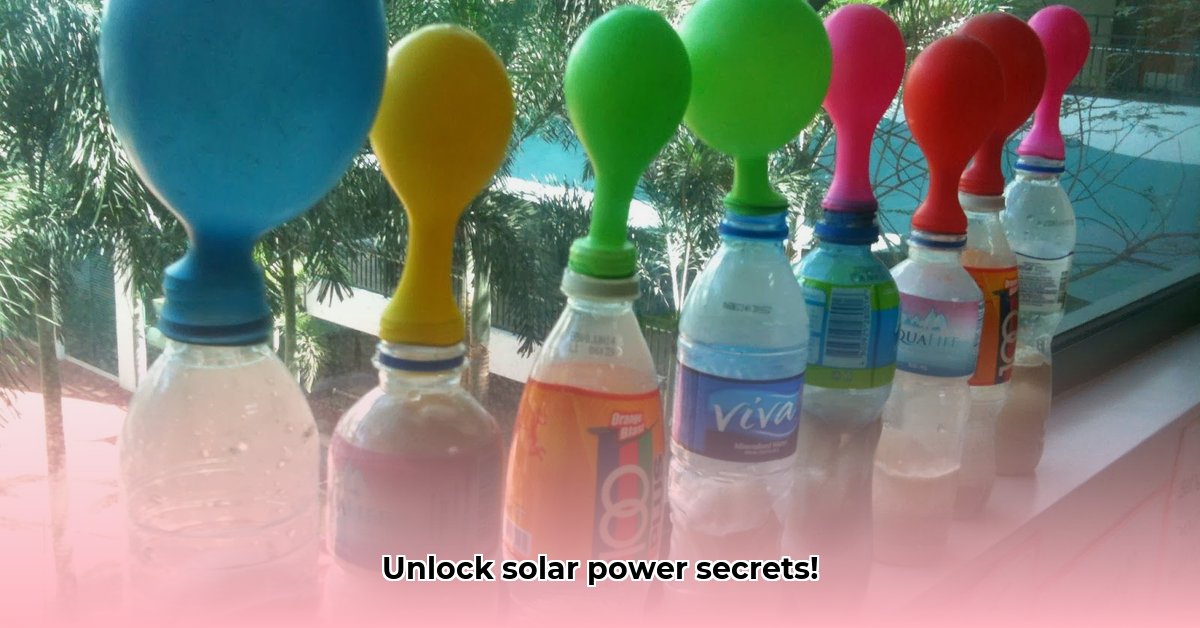Ever wondered how the sun can make things hot enough to cook food? Learn more about solar energy’s power here. Get ready for some awesome science experiments that show you the power of the sun! We’ll build a solar oven and do other cool projects to learn all about solar energy – it’s a super important way to get power that’s good for the planet. We’ll make sure it’s safe and fun, so grab your friends and let’s get started on this exciting journey into the world of sunshine science!
Solar Energy Experiments for 5th Grade
Renewable energy sources, STEM education, hands-on learning
Hey there, future scientists! Ready to unlock the sun’s amazing power? These super-cool experiments will show you how solar energy works – it’s fun, educational, and helps the planet too! Get ready to be amazed!
Safety First! Always Remember These Important Rules
Child safety precautions, science projects, parental supervision
Before we dive into the fun, let’s talk safety. These experiments are best done with a grown-up nearby to help and keep you safe. Some things to keep in mind:
- Hot Stuff: Some experiments might involve things that get hot from the sun, like a solar oven. Never touch anything hot without asking a grown-up first. Use oven mitts or pot holders!
- Sharp Objects: Be careful with scissors or anything pointy. Grown-ups should help with cutting if needed.
- Eye Protection: If the experiment involves bright light reflecting, like with aluminum foil, it’s a good idea to wear sunglasses to protect your eyes.
- Wash Your Hands: Always wash your hands after completing science experiments, especially before eating.
Let’s have fun and stay safe!
1. Building a Solar Oven: Bake Cookies the Sun’s Way!
Homemade solar oven, DIY project, baking with sunlight
This experiment will show you how sunlight can create heat – enough to bake a yummy treat!
What You’ll Need:
- A pizza box (the bigger, the better!)
- Aluminum foil
- Black construction paper
- Clear plastic wrap (or a clear plastic oven bag)
- Tape (packing tape works best)
- Scissors or a craft knife (adult use only!)
- An oven thermometer (optional, but helpful!)
- Ruler or wooden dowel
- Your favorite cookie dough or other sun-safe treat (marshmallows and chocolate for s’mores are great!)
Let’s Do It!:
- Prepare the Box Flap: Using scissors or a craft knife (adult supervision needed!), carefully cut a flap in the top of the pizza box, leaving about a 1-inch border around three sides (the sides and front). Fold this flap back to create a door.
- Line the Inside: Cover the inside bottom of the pizza box with the black construction paper. Tape it securely. This is super important because black absorbs sunlight like a champ!
- Create the Window: Cover the opening created by the flap with clear plastic wrap (or the oven bag). Stretch it tightly and tape it securely to the inside of the flap. This lets the sunlight in but traps the heat inside creating a greenhouse effect.
- Mirror, Mirror: Wrap the inside of the flap with aluminum foil, shiny side facing in. Tape it securely. This will reflect more sunlight into your oven, helping it heat up faster. You can also line the inside walls of the pizza box for extra reflection.
- Prop it Open: Use a ruler, wooden dowel, or even a pencil to prop the foil-covered flap open at an angle. This will help direct the sunlight into the box.
- Bake Time!: Place your cookie dough (or marshmallows and chocolate for s’mores) on a dark paper plate or piece of cardboard. Position the oven in direct sunlight, adjusting the angle of the flap to maximize sunlight entering the box. Use the thermometer to check the temperature inside if you have one. It will take longer than a regular oven, so be patient! Rotate the oven every 30 minutes to keep it facing the sun.
- Taste Test: Once your treat is cooked (it might take an hour or two, depending on the sun!), carefully remove it with oven mitts or pot holders and enjoy your sun-baked snack! Think about how the sun’s energy made it happen.
What Did You Learn? The darker colors absorb more sunlight and create heat. The aluminum foil reflects sunlight into the box, and the plastic wrap traps the heat. Your oven worked because it trapped sunlight’s energy, demonstrating the greenhouse effect!
2. Solar Water Heater: Which Bottle Gets Hotter?
Solar water heating, heat absorption, renewable technology
This experiment demonstrates how solar energy can heat water. It’s a simple but effective way to see the power of the sun.
You’ll Need:
- Two clear plastic bottles (the same size, like water bottles)
- Black paint (or black electrical tape)
- Water
- Two thermometers
- A sunny spot!
- Optional: Cardboard box to place the bottles in.
Here’s How:
- Paint or Tape Party!: Paint one of the bottles completely black. Alternatively, wrap it tightly with black electrical tape. Let the paint dry completely.
- Fill ‘Em Up: Fill both bottles with the same amount of water (leaving a little space at the top).
- Thermometer Time: Place a thermometer inside each bottle, making sure the bulb is submerged in the water.
- Sunshine Showdown!: Place both bottles in direct sunlight. For better results, place them inside a cardboard box lined with aluminum foil to reflect more sunlight onto the bottles.
- Regular Checks: Check the water temperature in each bottle every 15-30 minutes for a few hours. Record your findings in a notebook.
- The Results: Which bottle’s water got warmer? By how much? Why do you think that happened? The black bottle absorbs more heat from the sun, making the water warmer.
What Did You Learn? Different colors absorb heat differently. Darker colors are better at absorbing the sun’s rays. This shows how solar water heaters work!
3. A Simple Solar Panel: Powering Up with Sunlight!
Photovoltaic cells, solar panel experiment, energy conversion
This experiment provides a basic look at how solar panels work: turning sunlight into electricity!
What You’ll Need:
- A small solar panel (easily found online or at science supply stores)
- A small DC electric motor (the kind you can find in small toys or hobby shops)
- Alligator clip leads or wires to connect them
- A bright light source (a strong flashlight or direct sunlight)
- Optional: A small fan with blades that fit the motor’s shaft.
Let’s Go!:
- Connect the Parts: Carefully connect the wires from the solar panel to the terminals of the motor using the alligator clip leads. Make sure the connections are secure. An adult should help with this part, especially if soldering is required!
- Shine a Light!: Shine a bright light onto the solar panel. What happens?
- Amazing!: The solar panel converts the light into electricity, which makes the motor turn! If you have a small fan, attach it to the motor’s shaft to see the solar power in action!
What Did You Learn? Solar panels transform light energy into electrical energy, which can then be used to power other devices. This is photovoltaic conversion!
4. Comparing Surface Absorption: The Color Code of Heat
Heat absorption experiment, color and temperature, solar science
This experiment is all about figuring out how different colors absorb heat from the sun.
You’ll Need:
- Several pieces of colored construction paper (black, white, red, blue, green, yellow, etc.)
- A thermometer
- A sunny spot
- A piece of cardboard or a flat surface to place the papers on
Experiment Time:
- Sunshine Test: Place each piece of paper on the cardboard in direct sunlight. Make sure they are all exposed to the same amount of sun.
- Temperature Check: After about 15-20 minutes, use the thermometer to measure the temperature of each piece of paper. Place the thermometer on the surface of the paper to get an accurate reading.
- Record Your Results: Write down the temperature of each color in a notebook.
- Results: Which color got the hottest? Which got the coolest? Why do you think that happened? Darker colors absorb more sunlight and turn that energy into heat, while lighter colors reflect sunlight.
What Did You Learn? Some colors absorb more heat from sunlight than others. Dark colors absorb more, while light colors reflect more. This is why people often wear light-colored clothing in the summer!
5. Tracking the Sun: Where Does the Sun Go?
Earth rotation, solar movement, sun tracking project
This experiment explores how the sun’s position changes throughout the day.
What You’ll Need:
- A straight stick or a dowel rod (about 1
- Hydro Extrusions USA Leads North American Aluminum Profile Solutions - December 28, 2025
- Hydro North America Leads Aluminum Extrusion Solutions Across Diverse Industries - December 27, 2025
- Hydro Extrusion North America Provides Custom Solutions Across Diverse - December 26, 2025
















